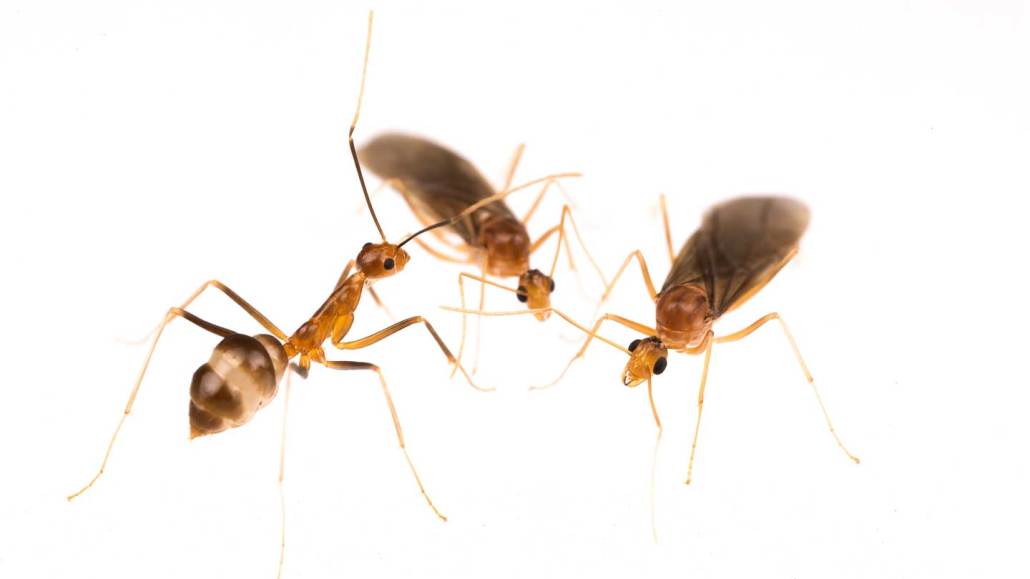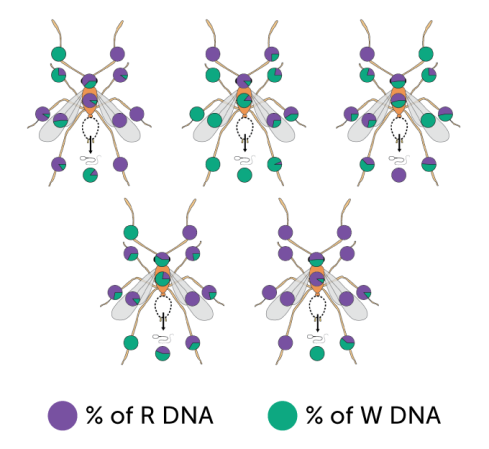
In yellow crazy ants, female workers (one shown at left) and males (two on right) are produced by combining sex cells from two distinct genetic lineages. But the DNA-filled nuclei don’t merge in males, meaning they carry two types of cells with distinct genetic material, or genomes.
© Hugo Darras
- More than 2 years ago
Yellow crazy ants break the rules of reproduction.
Every male ant contains separate populations of cells from two distinct genetic lineages, making them “chimeras,” researchers report in the April 7 Science. Yellow crazy ants (Anoplolepis gracilipes) are the first known species that requires chimerism to create fertile males.
It’s “an elegant response to the kinds of unusual mating systems we’ve observed in other ants,” says evolutionary geneticist Waring “Buck” Trible of Harvard University, who was not involved in the study. “We might consider this as the next evolutionary step” in ants.
Most animals develop from a sperm cell and an egg cell uniting into one, combining their DNA. As a creature grows, all of the subsequent cells, save for sex cells, carry two sets of DNA-bearing chromosomes, one from each parent. In other words, these somatic cells all carry the same genetic information. Sperm and egg cells contain just one set of chromosomes.
But in many ants, along with other insects like wasps and bees, only females have somatic cells with chromosome pairs. Males typically develop from unfertilized eggs. So their somatic cells hold just one set of chromosomes.
A 2007 study, however, found that about half of the sampled male yellow crazy ants possessed two different copies of the same genes, just like the species’ female worker ants.
But “it didn’t make any sense that all males in this species would be diploid,” or have two sets of chromosomes in each somatic cell, says evolutionary biologist Hugo Darras of Johannes Gutenberg University Mainz in Germany. When this happens in other ants, the males are usually sterile, he says. “Nobody had any explanation.”
So Darras and colleagues collected hundreds of yellow crazy ants from across East and Southeast Asia. Analyzing females — queens and workers — revealed that royalty in this species has a genetic source. Reproductive queens came from combining sperm and egg cells from the same lineage, which the researchers dubbed R. Workers were hybrids of the two different lineages, the other being called W. In other words, workers had R/W genomes, while queens had R/R genomes.
Consistent with the previous study, the researchers identified R/W males. But they also found that males’ somatic cells have just one set of chromosomes, as in other ant species. Extracting DNA from individual cells showed that rather than having chromosome pairs within cells, each cell contains chromosomes from just one of the two lineages.
Further experiments found that the R and W cells are unevenly distributed throughout the males’ bodies. While most of the body contained majority R cells, almost 75 percent based on the sampled tissue, the ratio nearly flipped in the sperm — 65 percent were W cells.

Since both workers and males come from combining W sperm with R eggs, the sex depends on whether their packets of DNA, or nuclei, merge. Fusion creates a female. But failure to fuse causes the two nuclei to divide separately within the same egg, producing a male.
It’s unclear why this never-before-seen mode of reproduction evolved in these ants. “By refusing to fuse with the egg cell, [the sperm] might be able to increase its reproductive output,” Trible says. Female worker ants are sterile and therefore can’t pass on the W genome.
“We think it’s maybe an interaction between two genomes that are in conflict but sometimes cooperate,” Darras says. These distinct lineages may have evolved independently in two separate ant populations that eventually intermingled. Or they could have started with similar genes that diverged over time, he adds. “But it looks like the whole genomes are separated and don’t exchange any genetic material.”
This odd reproduction method could be advantageous for the ant populations, leading to the yellow crazy ant’s title as one of the world’s worst invasive species (SN: 9/15/09). Because fusion of R and W nuclei results only in sterile workers, the genomes can never mix and be passed to the next generation. Thus, the ants avoid any possibility of inbreeding, a feature seen in other invasive ant species (SN: 2/1/11).
Chimeras have been found in other creatures, including humans, but it’s usually an accident. Yellow crazy ants are the first known species in which chimerism determines sex. But some scientists estimate there are around 20,000 ant species, and the reproductive systems of most haven’t been studied.
“This is a very special system,” says evolutionary biologist Guojie Zhang of Zhejiang University in Hangzhou, China, who was not involved in the research. “The question would be how frequently this system can be observed in other ant lineages.”






